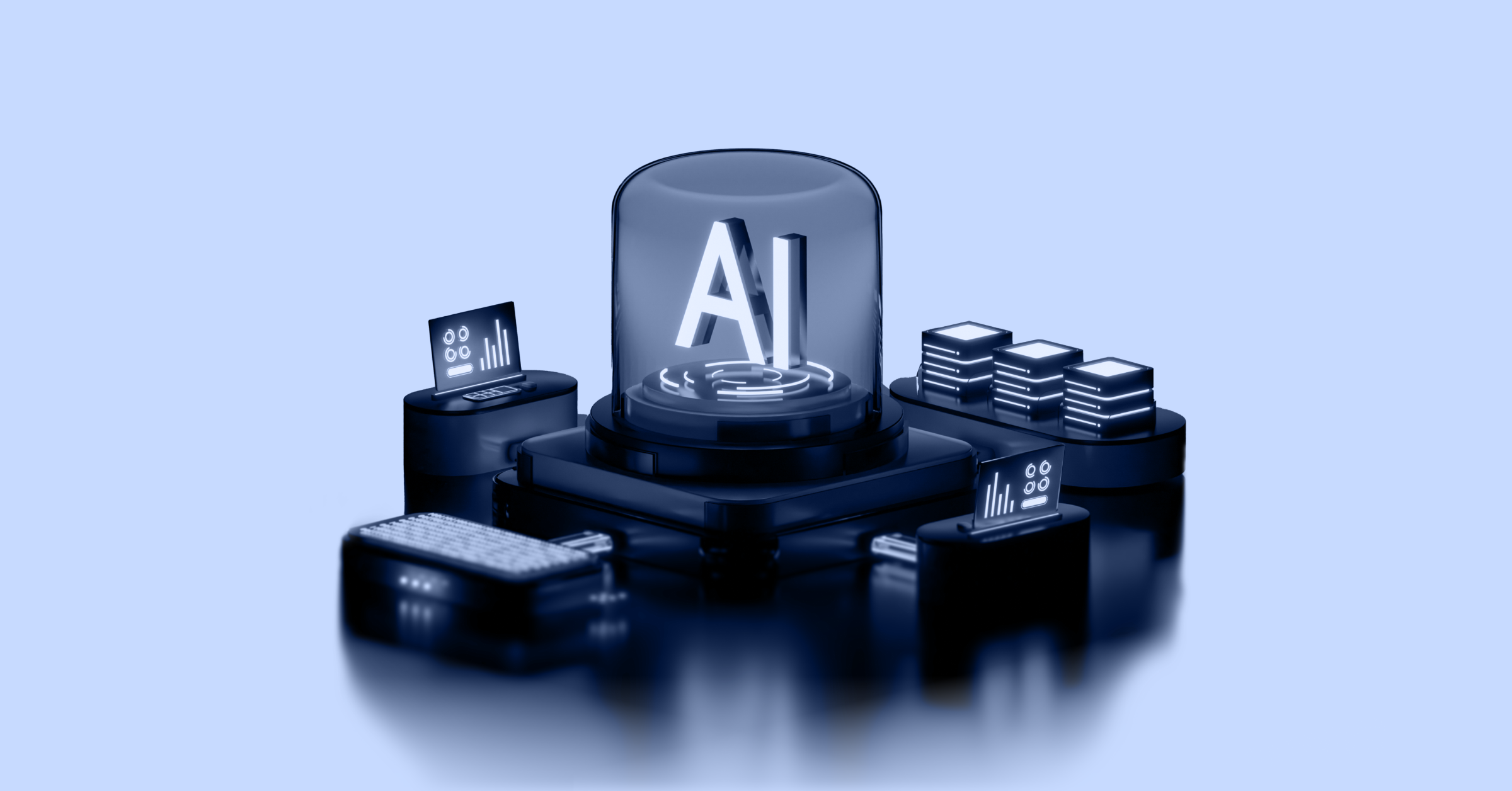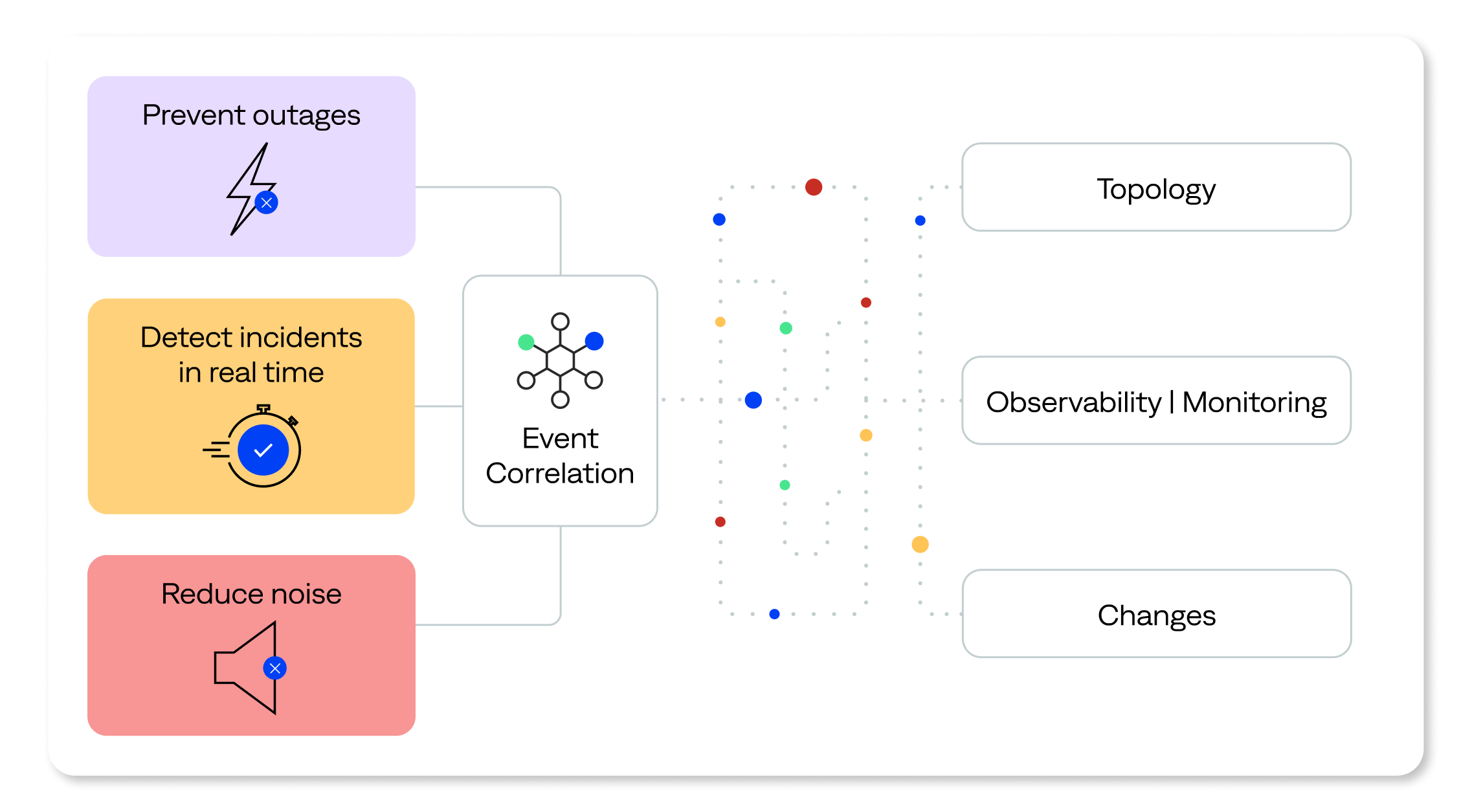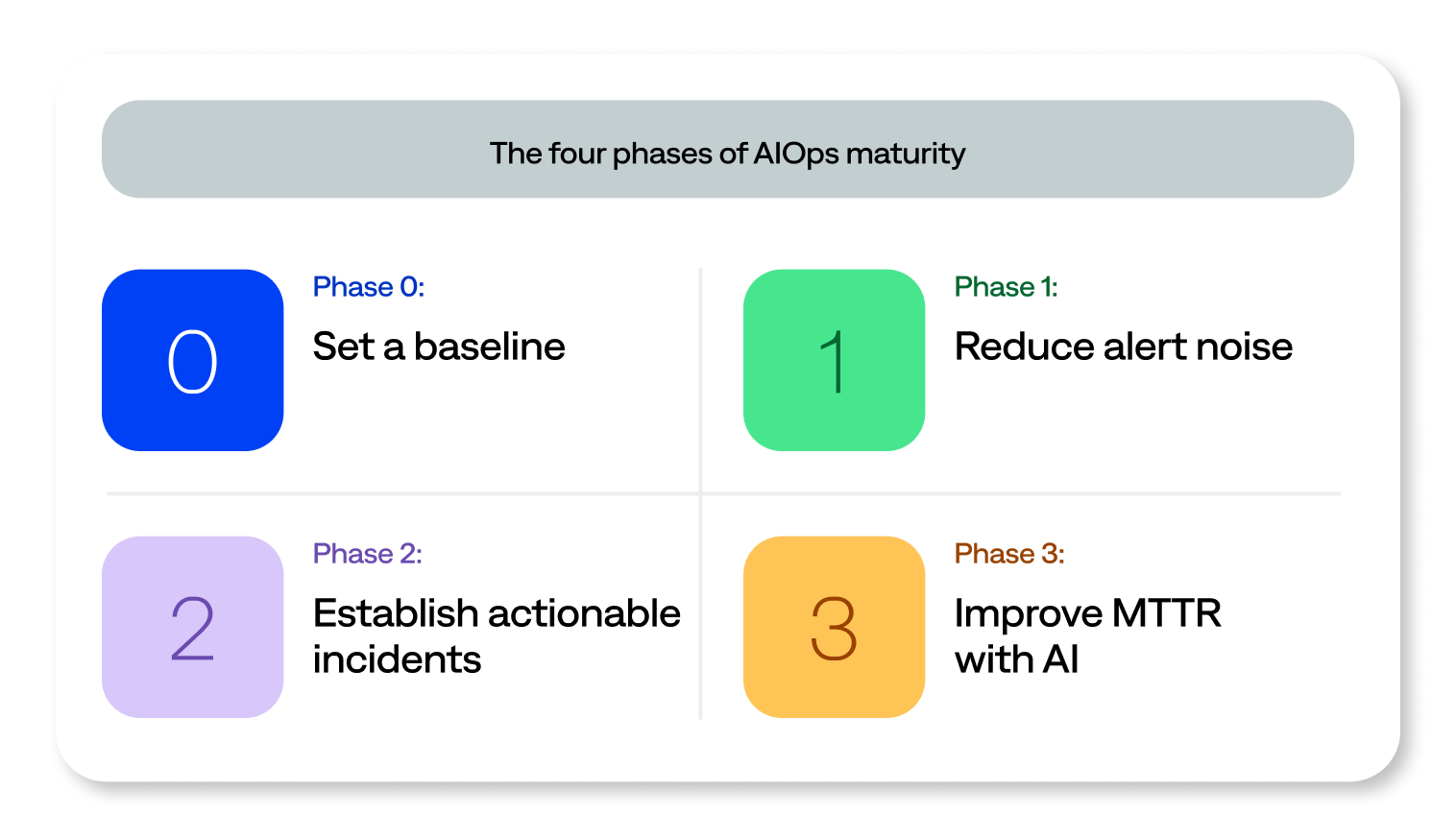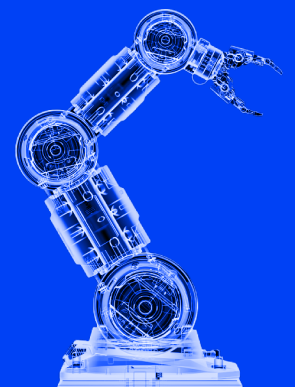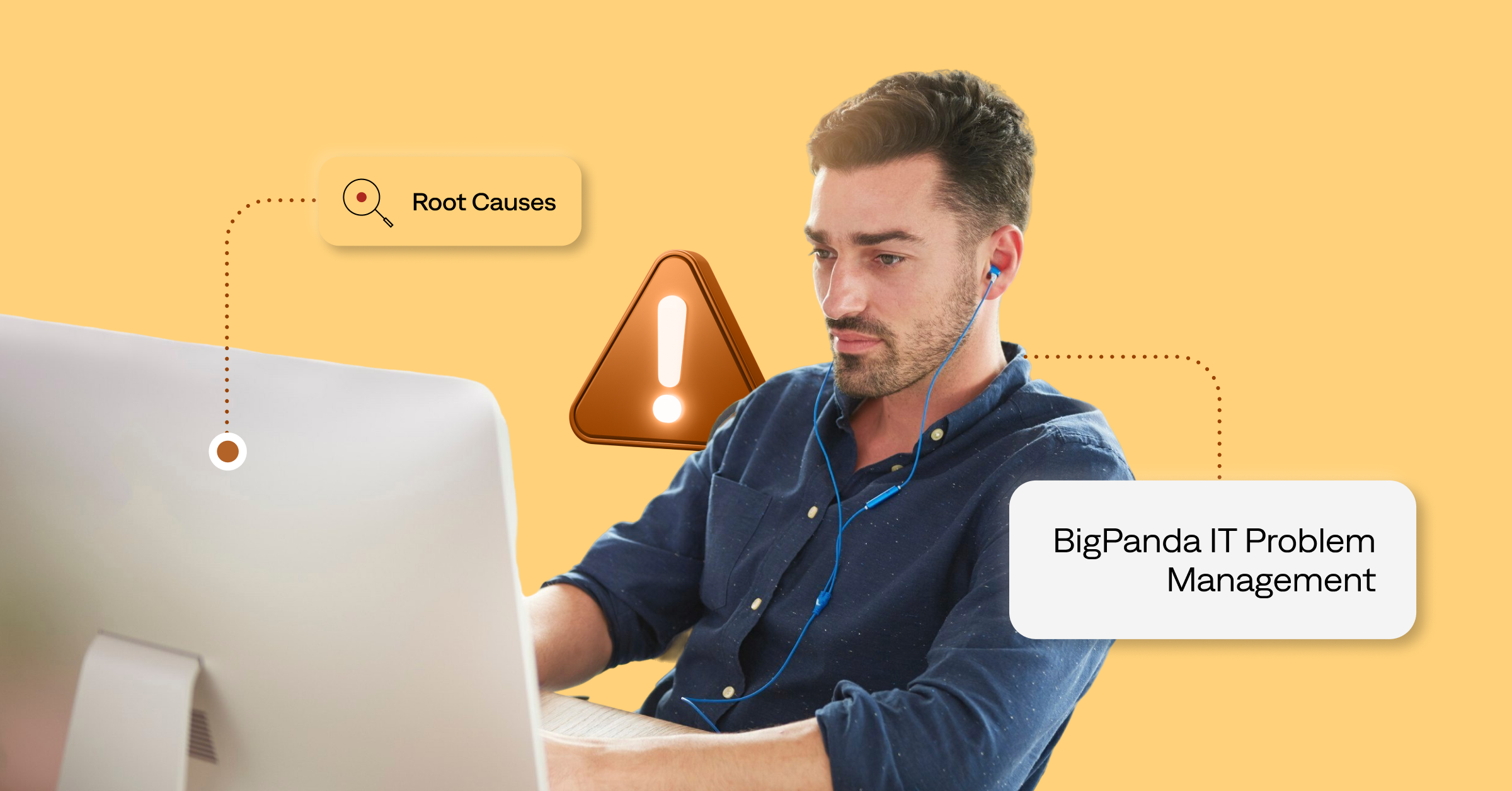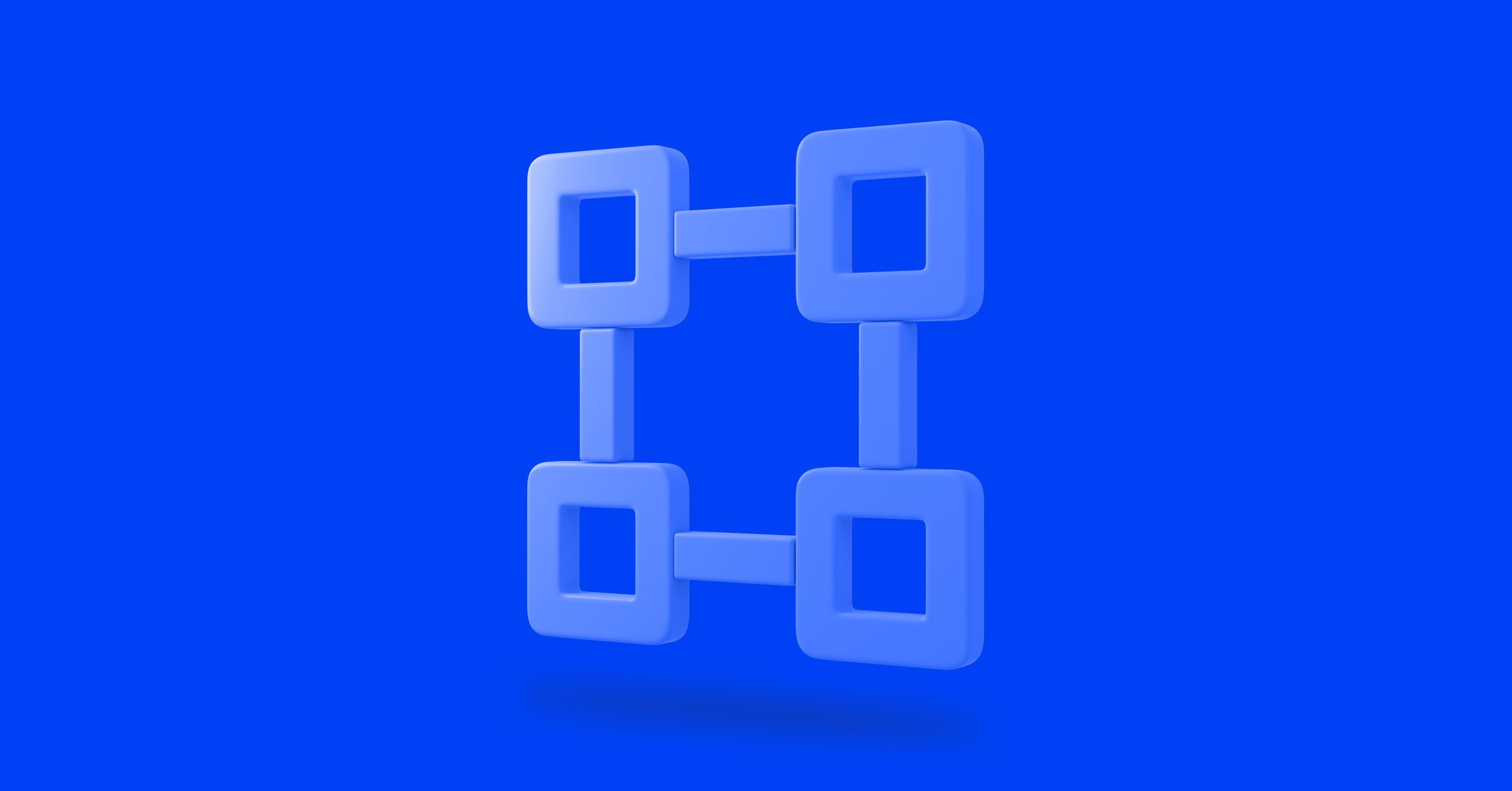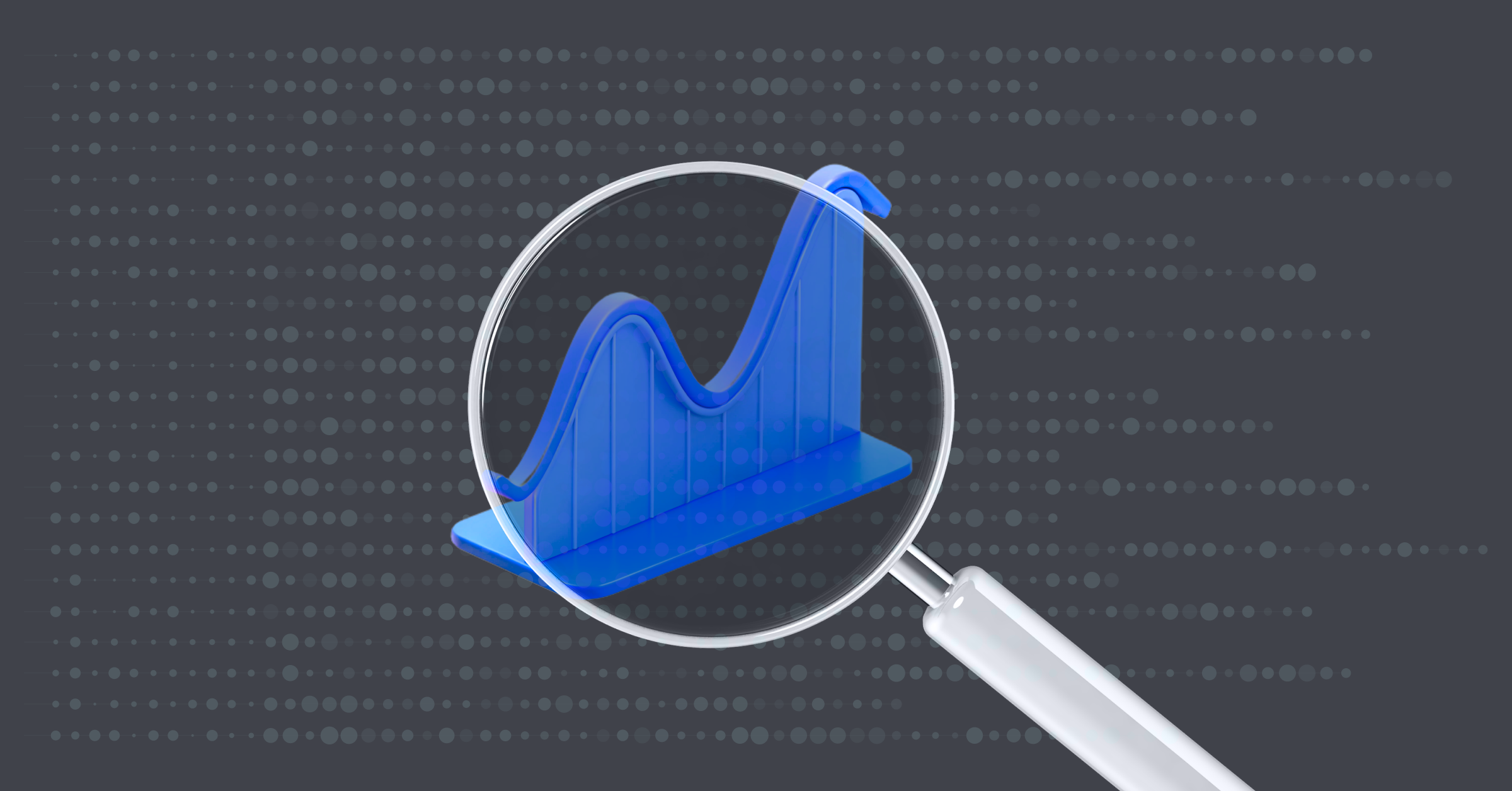What is an AIOps platform?

IT operations (ITOps) teams are challenged to keep pace with the rapid pace of digital transformation. As companies use more cloud-based apps, increase agile deployments, and develop new microservices-based applications, their technology stacks become exponentially more complex. This makes life increasingly challenging for the teams responsible for maintaining reliable IT services and infrastructure.
Hybrid tech stacks are siloed, complex, and fragmented. It’s nearly impossible for ITOps teams to manually sift through the huge volume of alerts to detect incidents, investigate them, and quickly respond. This results in lengthy Mean Time to Resolution (MTTR), poor operational efficiency, and disappointed customers.
AIOps has emerged as the solution to these challenges. AIOps means artificial intelligence for IT operations. Also known as event intelligence solutions (EISs), AIOps platforms apply artificial intelligence (AI) and machine learning (ML) to ITOps to automate, streamline, and optimize IT processes. These processes include event detection and correlation, anomaly detection, root-cause identification, and more.
Answering your AIOps platform questions
AIOps platforms use AI and ML to correlate millions of events into a small number of actionable alerts, detect and triage incidents, automate incident analysis, and automate notifications and ticketing. These capabilities can help drive continuous improvement in ITOps, reduce expensive escalations, and predict and prevent incidents before they become outages.
It’s essential to bring AI into your ITOps to scale your organization’s operations and remain competitive. To maximize the impact of AIOps, we have to understand some core capabilities and practices, and how AIOps interacts with tools like monitoring and observability. Let’s dive into some of the commonly asked questions about AIOps, and clarify why AIOps is critical for optimizing ITOps performance.
Read on to learn:
- What is an AIOps platform, and what does it do?
- What are the common use cases of AIOps solutions?
- How do AIOps platforms work?
- How do AIOps platforms help with event aggregation and alert correlation?
- How do AIOps platforms enhance observability and monitoring tools?
- How does AIOps improve event management?
- What are the phases of AIOps maturity?
- How do AIOps platforms help businesses?
- How does agentic AI improve AIOps and ITOps?
- How to choose a platform that delivers tangible business impacts.
What is an AIOps platform, and what does it do?
AIOps platforms leverage artificial intelligence, automation, and machine learning to streamline and accelerate various crucial IT operations functions. By using advanced algorithms and ML capabilities, AIOps can process and analyze vast amounts of data in real time. AIOps platforms can quickly identify patterns, anomalies, and correlations, provide actionable insights, and automate tasks that would otherwise be time-consuming and prone to human error.
What are the common use cases of AIOps solutions?
Common AIOps platform use cases include incident management and IT workflow automation. According to a recent survey by Enterprise Management Associates, IT outages can cost large enterprises more than $1.5 million per hour. With an effective AIOps platform in place, enterprises can decrease the frequency and cost of outages by 30% and reduce their duration to under an hour.
AIOps achieves this by ingesting alerts and enriching them with topology, CMDB, and change data, and unstructured operational data to reveal crucial contextual insights. These capabilities facilitate real-time event correlation and enable IT operations teams to quickly detect, triage, and resolve significant incidents. AIOps platforms also significantly improve operational efficiency by automating critical incident management tasks to accelerate remediation and reduce MTTR.
How do AIOps platforms work?
AIOps platforms bridge the gap between complex modern IT environments and the need for streamlined, effective incident management. AIOps performs event correlation, collecting and analyzing observability, topology, and change data. This incident intelligence allows teams to identify problems in real time to prevent and resolve outages proactively, resulting in streamlined processes and fewer outages. AIOps platforms offer several critical capabilities.
- Ingest, process, and analyze vast amounts of monitoring and observability data: AIOps collects multi-source event and alert data from diverse network resources, including storage devices, servers, user devices, and cloud infrastructure.
- Remove redundant alerts and reduce alert noise: AIOps combats alert fatigue by dramatically reducing the volume of alerts your teams have to evaluate. Filtering out non-essential alerts enables your teams to maintain high vigilance and promptly resolve important issues.
- Automate analysis: AIOps uses advanced AI algorithms to rapidly and effectively analyze vast amounts of IT data. This analysis goes beyond what traditional IT operations can achieve by manually sifting through alerts and data.
- Provide insights and recommendations: Leveraging AI, AIOps derives valuable insights from the collected data and offers prescriptive recommendations for enhanced incident management.
- Improve operational efficiency and effectiveness: AIOps can automate manual processes, significantly enhancing the efficiency and speed of ITOps compared to legacy IT processes that rely on manual initiation and alert-based response.
How do AIOps platforms help with event aggregation and alert correlation?
AIOps platforms streamline event aggregation by consolidating multiple related events into a single alert, simplifying the information for efficient handling. AIOps also excel at alert correlation, grouping related alerts into meaningful incidents through pattern recognition. They provide a consolidated view of interconnected events and their underlying causes for swifter incident recognition and resolution.
What’s the difference between event aggregation and alert correlation?
Event aggregation combines multiple related events from different sources into a single, unified event, while alert correlation identifies and analyzes relationships between events to create a more comprehensive picture of an incident. Aggregation focuses on consolidating similar events, whereas correlation focuses on identifying and linking distinct events based on their relationships and patterns. Both techniques are essential for maintaining the reliability and performance of IT systems.
Event aggregation
Event aggregation is the process of aggregating multiple related events created by monitoring and observability tools into a single alert. An event can be something simple and harmless, such as a user changing their login, or it can signify a problem within the infrastructure. Once events are normalized, deduplicated, filtered, and enriched, event aggregation groups related events into alerts. These alerts are now ready for event correlation.
Event correlation
Event correlation is the process of grouping related alerts into one high-level incident. By using pattern recognition, AIOps dynamically clusters alerts into meaningful incidents and provides patterns. BigPanda uses AI to correlate alerts into actionable incidents, reducing alert noise by at least 80% and giving teams actionable insights to resolve incidents before they become outages.
How do AIOps platforms enhance observability and monitoring tools?
AIOps transforms the effectiveness of observability and monitoring tools. ITOps, Network Operations Center (NOC), and Site Reliability Engineering (SRE) teams depend on gathering data from various observability and monitoring tools. Alone, these tools often produce overwhelming and unclear alerts.
AIOps platforms enhance observability and monitoring tools by filtering, deduplicating, and normalizing the data they produce. AIOps further enhances this data with operational context that is often missing from the original alerts.
AIOps platforms excel at detecting and identifying patterns, surfacing root cause, and pinpointing potential issues that may have otherwise gone unnoticed. This empowers IT teams to proactively address problems in complex, fragmented, fast-moving environments.
What’s the difference between observability and monitoring tools?
Monitoring tools are designed to provide real-time insights into the environment’s state and generate alerts when predefined thresholds or conditions are met.
Observability tools provide a comprehensive view of complex, distributed systems by collecting a wide range of data, including metrics, logs, traces, and events. In contrast to monitoring tools, observability tools focus on external outputs to provide insights into the behavior of systems and applications.
How do observability and monitoring tools use data differently?
Monitoring systems collect and analyze predetermined data from individual systems to offer real-time insights into performance and anomaly detection. Monitoring tools use preset thresholds, including database status, disk usage, and the status of various IT components.
Observability tools provide a more comprehensive view of system behavior, support historical analysis, and enable in-depth troubleshooting by collecting and analyzing diverse data types.
How does AIOps improve event management?
AIOps enhances event management by automating tasks, reducing alert noise, and accelerating incident investigation and resolution. AIOps can automatically analyze large amounts of data gathered from across the infrastructure t unusual patterns or signs of trouble. This helps prioritize alerts, ensure that IT teams concentrate on the most crucial issues, and avoid exhaustion from excessive alerts.
Moreover, AIOps offers early warnings about potential problems, enabling teams to take preventive measures. It also speeds up incident resolution through automated responses and recommendations for appropriate actions. Overall, AIOps boosts the efficiency and effectiveness of the entire monitoring and event management process.
What are the phases of AIOps maturity?
While many companies want to implement AIOps solutions, there is a wide variation in how effectively these solutions are being deployed and the results they are able to deliver. Based on our experiences helping hundreds of enterprises successfully deploy AIOps, we’ve created a practical guide that explains the four phases of AIOps maturity.
This guide will help your organization understand its AIOps maturity phase, assess the effectiveness of your AIOps deployment, and identify areas for enhancement.
The phases of AIOps maturity are:
- Phase 0 — Set a baseline.
- Phase 1 — Reduce alert noise.
- Phase 2 — Establish actionable incidents.
- Phase 3 — Improve mean time to resolution (MTTR) with AI.
How do AIOps platforms help businesses?
AIOps platforms support businesses by providing the necessary tools and capabilities to transition from manual, reactive processes to proactive, automated, and efficient ITOps.
These capabilities include automating incident response, predicting and preventing issues before they become outages, and continuously refining processes based on feedback and advanced analytics. These capabilities enhance operational efficiency and business agility. Let’s explore how AIOps platforms achieve these outcomes and how BigPanda facilitates this transformation.
AIOps improves optimization and efficiency
- AIOps accelerates root cause analysis: Without root cause analysis, ITOps teams can’t determine why or where an issue occurred, so they can’t proactively prevent it from happening again. BigPanda offers automated root cause analysis to surface the probable root cause of an incident, including potential infrastructure or application changes that led to the incident, enabling your teams to resolve more issues in less time.
- Provide comprehensive visibility: AIOps provides complete visibility into hybrid cloud infrastructures, including observability and monitoring tools, applications, servers, and infrastructure.
AIOps improves data analysis and surfaces hidden insights
- Data aggregation: Gathering and centralizing data from all of your monitoring and observability tools is the first step to breaking down the silos between these sources. Gathering and centralizing this data also helps AI/ML models sift through it and uncover hidden patterns and insights.
- Data enrichment: AIOps platforms provide cross-domain alert enrichment with rich topological context so operators can identify meaningful patterns and quickly take action to prioritize and mitigate major incidents.
- Generative AI: The best AIOps platforms combine the latest generative AI innovations with high-quality, enriched IT alert data to automatically and reliably reveal key incident analysis, incident impact, and probable root cause in natural language. This lets you prevent escalations, reduce manual work, and shrink MTTR.
- Collect data from multiple sources: BigPanda moves beyond structured data to tap into the long tail of operational intelligence and transform scattered context into real-time insights. Our platform uses purpose-built AI for ITOps and incident management teams to detect incidents faster, automate triage and diagnosis, and augment responder expertise to reduce resolution times.
AIOps enhances incident management and automation
- Event correlation: Event correlation helps ITOps teams detect, investigate, and resolve incidents in real-time by correlating the enriched data using AI/ML. By correlating collected alert and topology data into a handful of context-rich incidents, AIOps platforms greatly reduce noise and enable teams to take action on incidents as they form. Event correlation improves service availability and infrastructure stability by helping ITOps identify and resolve incidents faster and more easily.
- Automate manual IT tasks: One of the most significant benefits of AIOps is eliminating time-consuming, manual ITOps work. Organizations’ ITOps, NOC, SRE, and DevOps teams can often get bogged down with manual triage and incident response tasks, which AIOps helps to automate.
How does agentic AI improve AIOps and ITOps?
Agentic AI is artificial intelligence that creates autonomous systems that can make decisions and perform tasks without constant human intervention. These systems, also known as AI agents, can adapt to changing environments, learn from experience, and collaborate with humans to detect, respond to, and prevent incidents at machine speed. Critically, agentic AI doesn’t require highly structured inputs to function, and can leverage all your messy, scattered data. This enables a radically different strategy that transforms static data into adaptive intelligence.
Agentic AI in ITOps evolves traditional AIOps by enabling autonomous decision-making and self-healing capabilities, moving from reactive to proactive and predictive management. AIOps primarily focuses on data analysis and anomaly detection. Agentic ITOps integrates AI agents that can not only analyze data but also act autonomously to resolve issues, optimize performance, and predict and prevent IT incidents.
Choose an agentic ITOps platform that delivers tangible business impacts
BigPanda transforms how enterprises detect, respond to, and prevent incidents. The BigPanda agentic IT operations platform is a sweeping evolution of our platform that introduces a brand-new set of AI-powered capabilities to help enterprises automate the manual and time-intensive workflows of ITOps and incident management.
BigPanda moves beyond structured data to tap into the long tail of operational intelligence and transform scattered context into real-time insights. Our platform uses purpose-built AI for ITOps and incident management teams to detect incidents faster, automate triage and diagnosis, and augment responder expertise to predict and prevent incidents.
BigPanda closes the gap between fragmented, manual detection and coordinated, confident, agentic resolution. We empower the teams that keep the digital world running to move faster, act smarter, and reduce operational costs.
